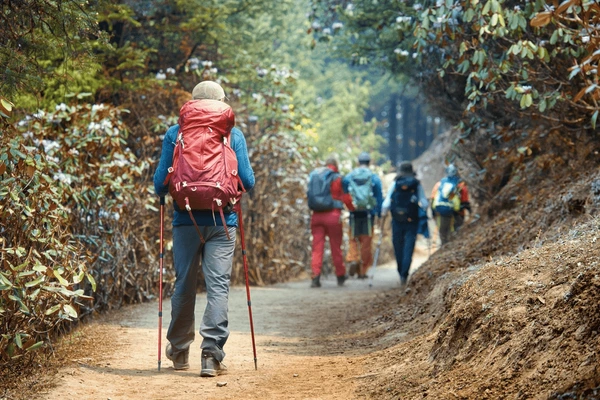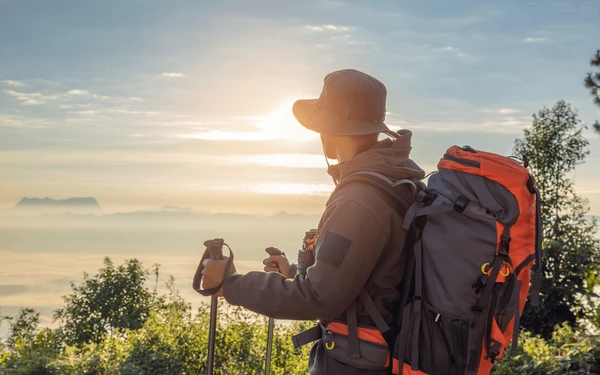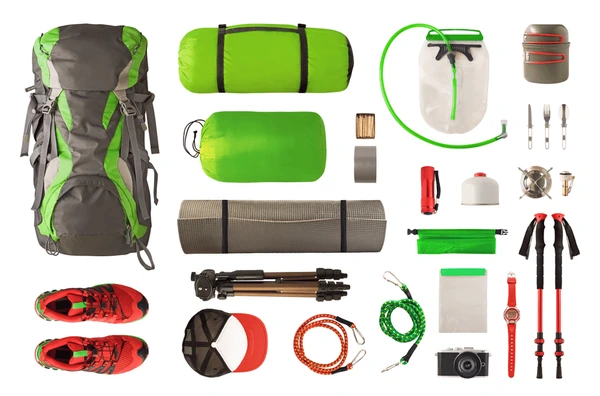Cost Involved
in Annapurna Base Camp Trek:
Introduction: Understanding the Costs of the Annapurna Base Camp Trek
The price of embarking on the Annapurna Base Camp trek holds importance for travellers looking to undertake this adventure in the Himalayas of Nepal. Various elements influence the expenses involved in the trekking experience including its duration, the necessity of travel insurance, essential trek permits and deciding between a guided group trek or going solo.
Whether you live in Nepal or India or if you are visiting from abroad it’s crucial to know the costs involved for planning purposes. To assist you in planning your trekking trip and ensuring a well prepared journey ahead we will outline the expenses, in detail in this guide.
Annapurna Base Camp Trek Cost Breakdown: Key Expenses

Travelers need to consider expenses when preparing for a trek, to Annapurna Base Camp. There are factors that dictate how much it will cost overall including permits, lodging transportation and whether or not to hire a porter or guide. Having an understanding of these costs can help plan your trip. This section breaks down the expenses to help get ready, for your adventure.
Annapurna Base Camp Trek Cost of Permit
Keep in mind the Annapurna Base Camp Trek Cost of Permit when you are planning for the Annapurna Base Camp trekking adventures expenses to budget for initially include the trekking permits. The Annapurna Conservation Area Permit (ACAP), along, with the Trekkers Information Management System (TIMS card).
The Annapurna Conservation Area Permit (ACPA) is required for every trekker visiting the Annapurna region. Plays a role, in supporting conservation activities in the region with permit costs varying based on nationality.
Foreign individuals are typically charged NPR 3.000 (to roughly USD 25). It costs approximately NPR 1.000 (around USD 8) for citizens of countries, like India. Hikers, from Nepal do not have to pay this charge.
The TIM card is used to monitor hikers, in the area for safety reasons with two variations available. One for solo hikers and another, for those accompanied by a guide.
Foreign individual hikers will need to pay NPR 2.000 (USD 15) for a TIM card. However, for hikers who are accompanied by a guide the cost’s NPR 1.000 (around USD 8).
For individuals, from countries interested in trekking in Nepal’s mountains with a guide will find that the TIM card is priced at approximately NPR 600 (equivalent to around USD 5) and for those trekking with a guide, at NPR 300 (approximately USD
Costs, for guides and porters
When you hire guides and porters for your trekking adventure they can make your experience more enjoyable by offering their knowledge and helping you avoid carrying loads on your own. The price of hiring these professionals may differ based on factors such, as their level of expertise timing of your trip and bargaining abilities.
Hiring a trekking guide comes with benefits such, as guidance along the trail and knowledge about the culture and environment while also ensuring your safety during the trekking journey. There is usually a fee of around USD 25 to 35 per day to hire a guide, for trekking trips which may increase during trekking seasons.
Hiring a porter can ease your burden by assisting with your luggage during your journey, at a daily rate of around USD 15 to 20 based upon factors, like luggage weight and trek duration.
Transportation Costs: Getting to Annapurna Base Camp

The adventure, toward reaching the Annapurna Base Camp starts well before embarking on the trail experience. A considerable portion of the trek expenses is attributed to the transportation to and from the trekking area. Many hikers kick off their expedition from Kathmandu. Make their way to Pokhara. The entrance point to Annapurna. Prior, to journeying towards Nayapul or Ghandruk for the trail commencement.
Kathmandu to Pokhara Transportation Costs
When traveling to Pokhara City, in Nepal’s region of Annapurna’s Mountain Range from the starting point of your journey by choosing from a range of transport options to suit your budget and comfort preferences can greatly influence the total expenses incurred during your trek to the Annapurna’s Base Camp site.
Flying from Kathmandu to Pokhara is the way to get there and usually takes about 25 to 30 minutes in the airplane seat. A choice, for those looking to save time and skip the long drive option! The price for one way tickets on flights typically falls between $100 and $125 for travellers, like yourself. Keep in mind that costs might fluctuate slightly depending on when you fly and which airline you choose to book with.
The tourist bus is the choice, at roughly $10 to $25 per person for a ticket fare. The trip by bus typically lasts between 6 to 8 hours’ subject to road conditions and traffic congestion. The buses depart early in the morning from Thamel, the tourist hub in Kathmandu. Reach Pokhara by afternoon. Luxury options are accessible with comfort levels at a price range of $25 to $35, per ticket.
Opting for a vehicle, like a car or jeep provides added flexibility and comfort to travellers seeking a personalized experience on their journey at a cost ranging between USD 120 to 150 for one-way travel. Though pricier, than public transportation options this choice grants the freedom to set your pace during the trip.
Pokhara to short Annapurna Base Camp Trek Cost
When arriving in Pokhara the next task is to make your way, to the point of the Annapurna a Base Camp hike at Nayapul or Ghandruk. Your decision, on how to get from Pokhara to these spots can impact your budget for the trek.
To get to Nayapul or Ghandruk from Pokhara you can opt for buses or jeeps. Buses typically cost between NPR 300 to 500 (around USD 3, to 5) taking about 1 to 2 hours. A choice among budget travellers. Shared jeeps are another option; prices vary from NPR 500 to 700 per person (USD 5 to 7) depending on your haggling prowess.
For added comfort and convenience, during your journey to the trailhead from Pokhara car or jeep can be hired for travel purposes costing around USD 30 to 40 for a vehicle to Nayapul and approximately USD 70 to 90 for a jeep to Ghandruk This choice allows for greater flexibility and a more direct path while saving time; however, it comes at a higher price, than using local transportation options.
Selecting the mode of transportation for the journey, between Kathmandu and Pokara and onwards to the beginning of the Annapurna Base Camp trek plays a role in organizing your trip expenses effectively. The interplay of these elements aids in managing convenience, time efficiency and financial considerations for an economical voyage, towards initiating your expedition.
Accommodation and Food Costs Along the Annapurna Base Camp Trek

When hiking to Annapurna Base Camp, in the Himalayas two key expenses each day are. Meals which can fluctuate greatly as one climbs higher due, to the challenges of supplying areas with necessities Knowing these expenses will assist trekkers in planning their budgets wisely for the trek ahead.
Tea House Accommodation Costs
During the Annapurna Base Camp trekking journey usually includes accommodations, in tea houses—a type of lodges that offer facilities for travellers. The expenses of lodging in tea houses tend to go up as the altitude increases because of the difficulties, in managing these shelters in terrains.
Cost per Night: On a night’s stay in a tea house accommodation can cost, between USD 3 to 10 (NPR 300 to 1000) with pricing varying based on the place and comfort level you seek Lower altitude villages generally offer more budget friendly rates compared to higher altitude settlements where prices may be higher due, to the challenges of transporting supplies to these remote regions.
Facilities: Many tea houses offer accommodations, with beds and shared bathrooms as standard options while ascending higher up the trail can provide additional amenities like charging stations for a fee. Additionally, hot showers are available at a cost of USD 2 to 5 depending on their availability, at the tea house.
Food and Drink Costs on the Trek
Trekking involves ensuring you eat well to stay energized, during the journey and tea houses along the path offer meals to hikers easily accessible at a cost that rises as you climb higher into the mountains to difficulties, in getting supplies these meals typically consist of high carb foods to keep trekkers fuelled up.
Typical meal prices, at a tea house usually consist of favourites such as dal bhat (rice with lentil soup) noodles dishes with soups or dumplings. In lower altitude regions you can expect to pay around USD 4 to 6 (NPR 400 to 600). As you move up in altitude the prices go up too and can range between USD 7, to 10 (NPR 700 to 1000).
Dal Bhat is an option, for trekkers as it offers servings in many places to fuel up for the long trekking days ahead. Prices typically range from $5 at altitudes to $9 to $10, at elevations.
At tea houses you’ll find drinks, like tea or coffee and bottled water for sale! Usually a cup of tea is around USD 1 to 3 at altitudes but it can cost a bit more at higher elevations. Maybe even USD 4 or 5! As you trek higher up the mountainsides the prices for water also go up from about USD 1 to around USD 3 or 4, per bottle! Some travellers choose to refill their water bottles or use purifying tablets to save money along the way.
Special Costs for Different Trekkers: Nepalese, Indians, and Foreigners

The cost of trekking to Annapurna Base Camp abc trek can differ based on one’s nationality as it mainly hinges on variations, in permit charges well, as transportation and lodging expenses. Let us break down the Annapurna base camp trek cost for Nepalese and Annapurna base camp trek cost for Indians.
Cost for Annapurna Base Camp Trek for Nepalese
Nepalese citizens do not need to pay the Annapurna Conservation Area Permit (ACAP) unlike trekkers who are required to do as a mandatory fee while trekking in the area. Apart, from that Nepalese citizens are not obligated to get a TIMS card. This makes it a significant way for them to save money in comparison, to trekkers.
Accommodation Expenses: Even though the rates, for accommodations at tea houses remain consistent for visitors of all nationalities in terms; Nepali hikers tend to have the perk of bargaining for costs when it comes to meals and shelter arrangements. Especially at lower elevations. Typically speaking Nepali trekkers can expect to spend around NPR 300 to 800 (equivalent to USD 2.50 to 7) during their stay, at tea houses with the prices varying based on altitude and available amenities.
Local Commuting Expenses: Nepali hikers have the option to save on transportation costs by opting for cost bus rides, from Kathmandu to Pokhara. Paying around NPR 500 to 1000 (equivalent to approximately USD 4 to 8) for a standard local bus seat. When heading from Pokhara to the treks starting point they can utilize buses or jeeps with fares ranging from NPR 300 to 500 (or roughly USD 3 to 5).
Annapurna Base Camp Trek Cost for Indian Trekkers
Indian citizens can enjoy discounts when obtaining trekking permits in Nepal. ACAP permits are priced at NPR 1 000 (around USD 8), for nationals. A rate that’s notably cheaper compared to what other foreign visitors pay. Moreover, Indian trekkers must also acquire a TIMS card which is priced at NPR 600 (USD 5) for trekkers and NPR 300 (about USD 2.50), for those trekking with a guide.
Accommodation Expenses: Similar, to Nepali hiker’s experience Indian hikers will be charged rates at tea houses priced between $3 to $10, per night varying with altitude and seasonal changes.
Transportation costs: Indian hikers have a variety of transportation choices when traveling from Kathmandu, to Pokhara. Tourist buses are an option among hikers and typically range in price from $10 to $25. The Annapurna base camp trek cost from pokhara to Nayapul or Ghandruk, Indian trekkers can opt for buses priced at NPR 300 to 500 or hire a private jeep for approximately $30 to $40.
Annapurna Base Camp Trek Packages: Is It Worth It?
When opting for an Annapurna Base Camp trek package deal, for your journey up the mountainside offers ease of travel. Does come with a greater price tag in contrast to trekking solo without assistance. These packages commonly consist of guides, porters, permits, meals, lodging and occasionally transportation. On average for a week trek expect to pay, between USD 500 to 700 for such a package although costs may differ depending on service quality and size of your travel party.
Base Camp Trek Package Inclusions and Costs
When opting for an Annapurna Base Camp trek package deal, for your journey up the mountainside offers ease of travel. Does come with a greater price tag in contrast to trekking solo without assistance. These packages commonly consist of guides, porters, permits, meals, lodging and occasionally transportation. On average for a week trek expect to pay, between USD 500 to 700 for such a package although costs may differ depending on service quality and size of your travel party.
Independent Trekking vs. Package Tours: Which is Cheaper?

Trekking independently provides flexibility. Is usually more budget friendly, with expenses varying between $300 and $400 USD. Though it demands preparation and hard work on your part it grants a customized adventure tailored to your preferences. In contrast guided package tours offer a defined itinerary, security and convenience beneficial for beginners venturing into trekking for the first time making them a worthwhile investment, for those prioritizing ease and comfort.
Travel Insurance and Altitude Considerations: Staying Safe
Heading to Annapurna Base Camp comes with risks due, to altitudes and thus having travel insurance becomes crucial for the trips safety factor as the remote location and potential altitude sickness may necessitate coverage for medical crises and emergency evacuations; otherwise a helicopter evacuation could cost more, than USD 5K.
Travel Insurance for High-Altitude Treks
When choosing insurance coverage, for trekking above 4 000 meters make sure it includes care and helicopter evacuations. Check that the policy provides accident protection tailored for high altitude pursuits.
Costs Related to Altitude Sickness and Health
Altitude sickness could lead to expenses, for medication. The need for more acclimatization days, in tea houses or even emergency evacuation services may be required at times too! To lower the chances of risks while climbing altitudes staying well hydrated and taking an approach are recommended; however, having insurance coverage can help ease the financial strain in case of any unforeseen complications that may occur.
Other Costs to Consider: Equipment, Permits, and Extra Days
When planning for the Annapurna Base Camp trek apart, from costs like food and accommodation trekkers must also consider expenses, for gear rental permits and possible extensions to their trip these additional costs can escalate especially if one has to hire equipment or faces holdups during the journey.
Gear Rental and Packing Essentials

If you find yourself without the required gear, for your trekking adventure in Nepal’s Kathmandu or Pokhara areas; there are options to either hire or purchase equipment at rates ranging from USD 1 to 5 per day for essentials like sleeping bags and trekking poles along with jackets and boots available, for rental as well. Buying gear can be quite expensive compared to renting it out which makes renting the choice for budget conscious travellers looking to embark on their journey without breaking the bank.
Extra Days and Unexpected Costs
You may need to adjust your trekking schedule due, to acclimatization needs which could prolong your journey and result in expenses for lodging and food well as possible guide fees; it’s a good idea to budget an additional $100 to $200, for unexpected costs ahead of time.
Natural Hot Springs and Other Experiences Along the Annapurna Base Camp Trek
The trek, to Annapurna Base Camp not provides mountain vistas but also allows hikers to indulge in tranquil activities such as unwinding in the soothing natural hot springs at Jhinu Danda—an esteemed resting point, on the journey back down. At Jhinu dandas hot springs entrance fee ranges from $2 to $5 (to NPR 2 to 500). Nearby guesthouses provide lodging for $5 to $10, per night – a spot to relax after a hike. In short, incorporating activities such as soaking in the soothing springs, at Jhinu danda can enhance the trekking experience and create lasting memories.
Conclusion: Budgeting for the Annapurna Base Camp Trek
The total expenses, for the Annapurna Base Camp trek cover costs such as permits fees for entry to designated areas and national parks in order to maintain the ecosystem and wildlife habitats undisturbed by increasing human traffic; lodging arrangements at tea houses or guesthouses where trekkers can rest and recharge after a day’s hike; meals to fuel the body for the demanding journey ahead; necessary equipment and gear to ensure safety and comfort on the trail; as well as optional activities like soaking in the relaxing Jhinu Danda hot springs to unwind amidst natures beauty.
For Nepali residents embarking on this adventure trek in their backyard of landscapes at more affordable rates due to special discounts on permits granted by their government authorities who acknowledge their contribution towards promoting local tourism industry growth; they also benefit from lower expenses on transportation services including buses or shared jeeps that ply along mountain roads connecting major hubs within Nepal’s tourism circuit. Make sure to plan in advance so that your trek, through the Annapurna region is enjoyable, without any surprise expenses Choose the option that suits your requirements and budget to have a trekking adventure.
